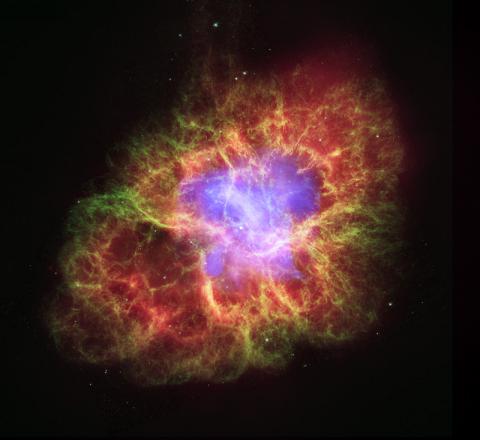This NASA image of Crab Nebula combines information from three separate space observatories: “The Chandra X-ray image is shown in light blue, the Hubble Space Telescope optical images are in green and dark blue, and the Spitzer Space Telescope's infrared image is in red. The size of the X-ray image is smaller than the others because the outwardly streaming higher-energy electrons emitting X-ray light radiate away their energy more quickly than the lower-energy electrons emitting optical and infrared light. The neutron star, which has the mass equivalent to the sun crammed into a rapidly spinning ball of neutrons twelve miles across, is the bright white dot in the center of the image.” Credit: NASA; ESA; CXC; JPL-Caltech; J. Hester and A. Loll (Arizona State Univ.); R. Gehrz (Univ. Minn.) and STScI.
Observing the night sky, in 1744, a teenaged boy from Badonviller, France - Charles Messier - saw something unusual. It wasn’t the first time this keenly observant lad had studied the heavens. But on this night, he saw a comet which had developed six tails.
A contemporary artist recorded how the comet appeared when its head was below the horizon. By March 8, 1744, the comet was visible in the predawn sky, its tails resembling a Japanese fan. Messier, for years thereafter, continued to search the sky hoping to see (or discover) more comets.
The Frenchman thus grew up with a profound love of astronomy. Observing, and recording, what he saw in the heavens became a career for him. Astronomers still use “M” designations, based on a catalog he created, to identify deep-sky objects with fixed positions.
His list includes such things as “fuzzy” non-comets known as nebulae. M1 (or, Messier 1), for example, is another name for the Crab Nebula.
Observed by Chinese astronomers in 1054 AD - when it was an exploding supernova - and discovered in 1731 by John Bevis (a British physician and amateur astronomer), the Crab Nebula is still one of the most studied of all objects in the sky. It takes its name from an 1844 (or thereabouts) drawing by William Parsons, the Third Earl of Rosse, who observed it with a 36-inch reflector at his home, Birr Castle, near Parsonstown, County Offaly, Ireland.
Thanks to the Hubble telescope, we can examine it in much greater detail than Lord Rosse could have ever imagined - even with his later 72-inch telescope which, for nearly a century, was the biggest in the world.
Hubble’s image of the Crab - assembled from twenty-four separate exposures - provides astronomers with incredible detail of the nebula. And, because of the space telescopes (Hubble, Spitzer and Chandra), scientists have learned how the Crab moves through space: It is propelled by a dynamic pulsar [PULSating stAR] at its core.
As we continue our virtual visit to space, let’s examine a few more notable nebulae.
To cite this story (For MLA citation guidance see easybib or OWL ):
Bos, Carole "THE CRAB NEBULA" AwesomeStories.com. Jun 01, 2008. Apr 26, 2024.<http://www.awesomestories.com/asset/view/THE-CRAB-NEBULA-Exploring-Space-Images-from-NASA/images/chandra_handra.xray.observatory_depicted.in.orbit_nasa.image.gif>.


 Back
Back
 Next Chapter
Next Chapter

 Back
Back
 Next Chapter
Next Chapter


